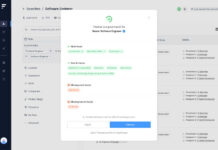
As HR technology professionals look toward 2019—and wade through the predictions about the coming year’s Next Big Thing—we think it’s worth considering the developments we’ve seen take place over the last 12 months. From our point of view, these are the five top stories of 2018.
AI Jumps Shark; HR Tech’s a Product Business
HCM technology customers are done with sales and marketing pitches that tout machine learning, artificial intelligence and the intricacies of other advanced technologies. Instead, they expect vendors to make the case for workable, reasonably priced solutions to the challenges they face in nearly every corner of HR.
As #HRTech pros wade through predictions about the coming year’s Next Big Thing, consider these 5 top stories of 2018. Click To TweetThat was made clear by conversations with HR tech buyers, users and even some solutions providers at October’s HR Technology Conference. We picked up distinct feeling that HR departments now focus their buying decisions on a product’s results as opposed to its underlying technology. While some people labeled terms like “AI” and “machine learning” as buzzwords, others described them as “table stakes.”
As one attendee put it: “AI’s not new anymore, so it’s not as exciting as it used to be. People want to know what’s going on with the software” and the outcomes it produces.
Amazon Debacle Spotlights Machine Learning’s Achilles Heel
AI and machine learning enthusiasts don’t like to talk about it much, but sooner or later they’ll admit metrics have biases. In October, Amazon learned that lesson the hard way and took its machine-learning recruiting tool offline after discovering that, as Reuters said, it didn’t like women.
Sources inside Amazon told Reuters the system had been under development since 2014. The goal was to review resumes by machine so recruiters could spend more time developing relationships and actually hiring people. Given that Amazon has all-but perfected the use of AI in so many other areas, the company’s applying advanced technology to hiring was a no-brainer.
But this time Amazon either aimed too high or just flat-out blew it. “Everyone wanted this holy grail,” one of Reuters’ sources said. “They literally wanted it to be an engine where I’m going to give you 100 resumes, it will spit out the top five, and we’ll hire those.” Instead, the system compared current applicants against patterns found in resumes submitted over a 10-year period.
Since so many more men than women populate the tech workforce, the system inevitably machine-taught itself that male candidates were stronger than their female counterparts.
One observer observed that, “machines only work when humans review their work and teach them how to provide better results. At its best, AI is a rookie on your team that presents problems with accuracy, ambiguity and accountability.”
Whether vendors and analysts will continue to push “AI” and “machine learning” as buzzwords during 2019 remains to be seen. For our part, we think they’d be better off focusing on “solutions.”
Vendors Must Push Buyer Executives to Understand HR Tech
More evidence surfaced that corporate executives are reactive rather than proactive when it comes to facing disruptive technology challenges. That often puts them at odds with current and prospective workers, who not only embrace technology in their personal lives but increasingly expect their companies to provide tools that have the same easy-to-use flavor as the devices they use at home.
A study by executive search firm Odgers Berndtson indicated global companies aren’t ready to face such dynamics. That’s especially worrying at a time when, PwC said separately, 65 percent of workers believe the quality tools allow them to do their jobs more effectively, but only 25 percent of HR departments have given high priority to deploying advanced technology in order to enhance the employee experience.
Odgers Berndtson found the CEOs of Asian-based multinationals worried that only half of their senior executives could be effective in dealing with disruptive change. Many also admitted to being reactive to change as opposed to leading it.
“Research shows that globally, over a third of top executives already fail to deliver on their mandate,” said Mark Braithwaite, a managing director at Odgers Berndtson. “The fact that so many now see a yawning gap between the leadership abilities their companies need and those their senior teams currently have is very worrying.”
The takeaway for HR tech vendors: Ramp up the educational components of your sales efforts.
KeenCorp’s Engagement-Tracking Tool Looks Like a Game-Changer
One of the most promising tools for truly measuring engagement entered the U.S. market KeenCorp, headquartered in Rotterdam, integrates its software with company email systems to gauge how employees feel at any given moment. Unlike surveys, it requires no effort by employees and, by layering into the company’s email system, ensures 100 percent participation.
KeenCorp’s product measures workforce engagement through language analysis and tension detection. It does this anonymizing all emails, then scanning them to measure the collective mindset of employees based on how they write. (Yes, it complies with EU and U.S. privacy regulations.) After establishing a baseline using historic email traffic, the tool scans current messages to detect pattern changes in their language, flagging both positive and negative trends.
What makes KeenCorp unique is its ability to deliver critical intelligence through the capture of data that already exists, or what’s come to be called “digital exhaust.” Another unique aspect of the product is its generation of hard data. And while KeenCorp positions its index as a way to track engagement levels, it’s worth noting that it does so primarily by measuring tension levels as much as enthusiasm. When employees are uncomfortable, the numbers drop. When they’re enthused, they rise.
Deloitte Trends Report Hints Companies Must Simultaneously Engage Employees, Customers
Deloitte’s 2018 Global Human Capital Trends report argued that businesses must take on a societal leadership role, and hinted that changes in workforce dynamics might put expanding the engagement efforts at the center of their strategies.
As the use of advanced technologies like AI, automation and workforce analytics continue to spread, employers are trying to reconcile the demand for human skills with the need for increased productivity, according to the report.
The report identified 2018’s “make or break” issue to be the need for C-level executives to recognize and act on business’s evolving role in society. As it turned out, it seems that business leaders spent more time playing defense about their role than taking meaningful action.
Sign up for our newsletter here.
Image: iStock















